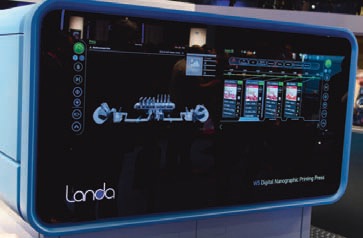Landa believes it is 85% of the way to achieving offset quality on its nanographic technology.
Benny Landa was in London in September and, armed with a range of impressive samples, and his customary optimism and enthusiasm, he provided Sean Smyth with an update on the progress of the Landa Digital Nanography project.
The team at Landa has been working on two main elements since the launch at drupa, to improve the print quality and to enhance the press design, to make a more efficient machine following much feedback from customers.
In the months following drupa, Landa has obtained 410 letters of intent (each with a deposit of around €10,000) from potential customers eager to be among the first users of the technology. This equates to several billion pounds worth of digital print equipment that will make a significant disruption to many parts of the mainstream print market when it happens.
New print samples, not full B1 size, are bright, crisp and clear, with good fine text, smooth tints and vignettes. The original samples from drupa contained many faults, with missing lines of dots, poor head alignment and some registration issues, and these issues have been largely overcome.
While he would not confirm the identity of the inkjet ejectors, Mr Landa did confirm that the native resolution has increased from 600 dpi to 1200 dpi, with five levels of grey to give an apparent higher resolution. This follows the advances made by Kyocera, which was widely credited with supplying the original heads. The screening technology allows either AM (amplitude modulation) giving the traditional dot rosette pattern of offset, or stochastic techniques that will hold more detail.
Mr Landa talks about achieving offset quality, and he believes the company is now 85% of the way: up from the 40% level seen at drupa. In the background, there have been improvements in software and ink technology and, as ever, the proof is in the eye of the beholder. Ilooked very closely and imperfections are still there, but it was well above the standard of much commercial offset (without seeing the originals).
Design for productivity
In fact, the biggest changes are in the design of the presses themselves. The huge touchscreen control panel has been moved to the delivery rather than the side of the press, and there is now an operator ‘cockpit’ that has the delivery, a large counter, an inspection table under controlled lighting, and a very impressive array of displays, including cameras showing the real time activity in the machine and job queues, etc.
There is another mini touchscreen alongside the infeed. This has moved the panel from the press side, so there will be much less running around for the operator and it will be easier to handle maintenance and servicing. This design has taken into account feedback from operators and users, and changes are aimed at boosting the up-time to make a more productive press.
The costs have not been finalised, but Landa still claims it will be the lowest cost consumable (ink/toner) of all digital processes, and will be cheaper than offset up to 5000 to 7000 B1 sheets. The cost per print will be competitive with analogue methods in mainstream print.
There will be a click charge that covers all inks and consumables, including replacement ink ejectors, transfer belts and other replaceable parts. There will also be a service contract to cover maintenance and support.
According to Benny Landa, the first installations will take place toward the end of 2014, at sites in Europe and the USA. This will be the simplex B1 carton press, the S10FC and the commercial S10 perfecting machine will follow, probably early in 2015.
There are eight sets of ink ejectors, giving four-colour process perfecting with an option to add another four print units as an option. It prints at a speed of 6500 B1 prints per hour, so 3250 duplex sheets up to 1050 x 750 mm between 60 and 350 gsm. Landa claims the use of the nano-sized pigments gives a much wider colour gamut than in offset or other digital print.
The much described mechanism means almost any stock can be used with no priming or treatment; there were some prints on toilet paper that looked good. The base press weighs 18.5 tonnes, with a footprint of 14 x 5.8 metres, and the process colour option is able to match 65% of Pantone colours while the sevencolour (with orange, green and violet) will be over 75% according to Landa.
Landa Corporation has finalised a cash injection of $200 million and is looking healthy, while upgrading engineering and production resources. There was no news on any of the licensees, but the Landa version will be the first to reach the market. I was at the ‘Ink Face’ when the first colour digital presses were installed and it was a tough time. Benny Landa says he will not make the mistake of launching technology that is not ready again.
The samples are better and the design looks more robust with high levels of automation. So, I am more convinced now that this technology will be changing the face of commercial print over the next three to four years. Welcome to another process.





